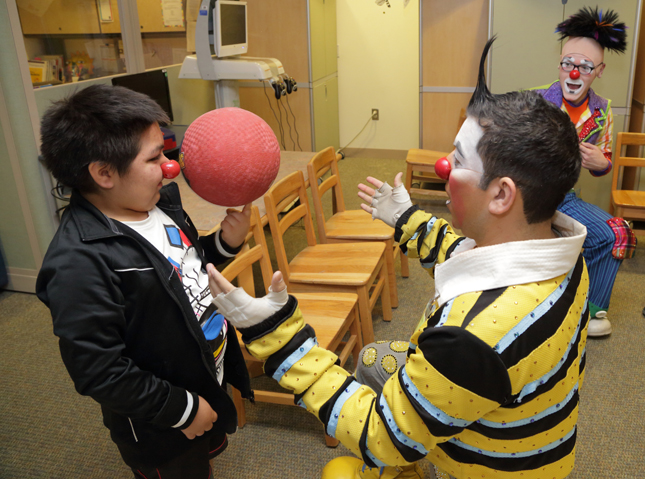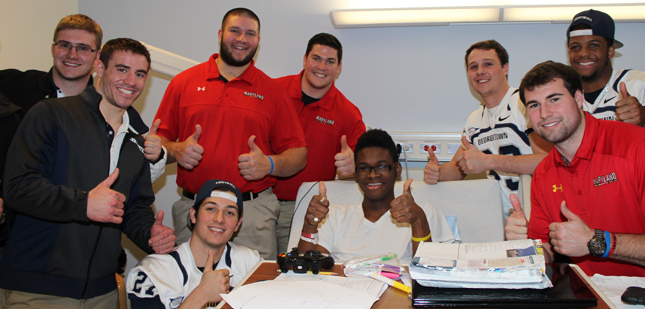

April 2014
IN THIS ISSUE:
![]()
- Someone to lean on
- Dalai Lama visits CC, lectures on science
- A closer look at the eating habits of children with autism, including those on gluten/casein-free diet
- Former NIH lab technician won 1946 Negro League Baseball World Series
- Dental association honors Dr. Bruce Baum for training initiatives
- Visitors clown around with patients, bring an uplifting atmosphere
- Large chromosomes found in frog, salamander eggs offer clues about RNA transcription
- Upcoming Events
Print this Issue ![]() (452 KB)
(452 KB)
ABOUT CC NEWS:
![]()
Published monthly by the Office of Communications and Media Relations. News, article ideas, calendar events, letters, and photographs are welcome. Submissions may be edited.
Clinical Center News
National Institutes of Health
Building 10, 10 Center Drive
Room 6C-420,
Bethesda, MD 20892-1504
Tel: 301-594-5789
Fax: 301-402-4984
Molly.hooven@nih.gov
2014 ISSUES:
![]()
QUICK LINKS:
![]()
Someone to lean on
Members of the community give back more than 22,000 hours
 |
Volunteers, such as those pictured above, have contributed 22,227 hours of service in 2013. (Left to right): Saroja Kanesathasan, Aunner Diaz, Beth Price and Daniel Riggins. |
Volunteers deliver an extra dimension of staff support for patients, families and visitors at the Clinical Center. And while it's often done during "free" time, it adds an amazing value to America's research hospital. In 2013, there were 238 volunteers who contributed 22,227 hours of service, the equivalent of almost 11 full-time employees.
Courtney Duncan, Clinical Center volunteer program coordinator, thinks that their "service is invaluable."
"The Clinical Center is a little different than most hospitals: our need is during the day. The volunteer program supports the Clinical Center and the associated Institutes working here," she said.
Saroja Kanesathasan, whose first name means "born out of the lotus" in her native Sri Lankan language, joined the volunteer staff as a recruit from the East-West Highway Red Cross chapter in 1981.
She was one of 20 community volunteers and has been helping on Thursdays ever since, outlasting the Red Cross chapter and most of the others who signed on with her. One of the rewards for Kanesathasan is interacting with the patients. As she makes her rounds with coffee or a library cart, she is often greeted with "Oh my gosh, I missed you!"
Kanesathasan has also seen people at their most vulnerable.
"I had a family from India and the gentleman was very young [and] had come for a bone marrow transplant with his parents and sister," she said. The family was so desperate for help that "they sold all their land to buy the plane tickets [and] had $25 after the trip from the airport and they used it to pay for the taxi." When they arrived at NIH, they "didn't have a cent."
Kanesathasan was instrumental in identifying resources for the family, so they could focus on their son's treatment. Her advice for anyone thinking of volunteering is to "put the patients first. They are under stress reach out to them. Give them a smile and let them know they are special."
Aunner Diaz, 18, is a volunteer in the pediatric unit and medical records department. Diaz first came to NIH with his grandmother who had leukemia.
"I learned a lot [at NIH] and after my grandmother passed away here, I wanted to give back," said Diaz. "It's a great place to be. In the pediatrics department I work the desk and I get to talk to the kids. I learn new things from them. A lot of them are very sick but you try to make them happy while you can. It's very rewarding. [As a volunteer] you have to be reliable, to be motivated."
A memory that he cherishes happened just recently. While working at the pediatrics desk, he was called over to celebrate the birthday of a patient. "It was his birthday, but it was also his last day here because he was healthy. We celebrated [and] I felt really close with everybody, it was like a family."
Few people know the CC as well as Beth Price, who worked at NIH as a clinical nurse from 1970 to 2013. Price now volunteers for her church, at a soup kitchen and for the humane society, as well as spending Wednesdays as a New Patient Escort in the Admissions program. Price helps reduce the stress associated with coming to a new medical facility.
"When you see new patients sitting in Admissions, they appear very anxious. Many of them know very little about NIH," Price said. "I often have the opportunity to escort new patients and their families to their first point of contact after completing the admission process. It is such a heartwarming experience when the patient and their family leave you with a big smile."
Having a connection to the Clinical Center and NIH community has made Price's volunteer experience more memorable, and she thinks other former NIH employees would also reap the benefits.
"I would encourage all those who have retired from NIH to seek out the ambassador program, to seek out any volunteer opportunity here and come back because you are really needed and your help will be appreciated," she said. "The reward is really priceless."
Daniel Riggins, a Michigan native, volunteers in radiology and is on a fellowship with the Food and Drug Administration in a bacteriology lab developing genetic tools for other researchers. He is heading to medical school this year and wanted to garner some clinical experience. "It seemed pretty natural to get a volunteer job here and it has been a really great experience," Riggins said. "What I like the best is how international the patient population is. It keeps you aware and engaged because you never know what to expect."
Riggins sees a real-life application of his volunteer experience. "I've done some shadowing and the doctors here are very good at improvisational problem-solving because a lot of times there's no real protocol for how to treat patients because they are on the cutting edge of these different diseases and treatments. It has been very cool to see the full picture and how everyone works together. It's very interdisciplinary. When you volunteer you get to be a silent observer and see those interactions."
Asked about the key skills he's developed during his time as a volunteer, Riggins said "conversational skills. There's different ways to start a conversation with people" and help them feel at ease. This has been a particularly useful skill at one of his other volunteer opportunities, teaching health lessons at a men's transitional shelter in Silver Spring for people shifting from being homeless to having their own apartment.
"Once you get started [volunteering], you just want to keep doing it," added Riggins.
Interested in becoming a volunteer? Learn more on how to become a volunteer.
| Dalai Lama visits CC, lectures on science
|
A closer look at the eating habits of children with autism, including those on gluten/casein-free diet
The dietary intake of children with autism was recently examined at the Clinical Center as part of the protocol "Clinical and Immunological Investigations of Subtypes of Autism." For the past five years, Lt. Cmdr. Jennifer Myles, a registered dietitian, has worked on the dietary portion of the study, which is an ongoing natural history investigation headed by Dr. Susan Swedo of the Pediatrics and Developmental Neuroscience Branch of the National Institute of Mental Health.
Many children with autism are prone to have selective eating, explained Myles. For example, they will or will not eat some foods based on textures, colors and shapes, due to their sensory and tactile hypo and hyper-reactivity symptoms.
But, there is an additional component. In an effort to help their children, some parents implement dietary restrictions they think might be therapeutic to better control their child's autism most often a gluten-free and/or casein-free diet. Gluten is a protein found in wheat, rye and barley and casein is a protein in dairy products.
"For this dietary portion of the study we wanted to look at the adequacy of the diet of these children with autism whether or not the food they consumed was meeting the dietary requirements," she said.
For the diet study, the parents of about 140 children, ages one to nine years old, completed a three-day food record.
The sample population consisted of three groups: children with autism, children with other developmental delays and children with typical development.
The autism group was further separated into a restricted diet (those following a gluten-free and/or casein-free diet) and non-restricted diet groups.
The goal was to determine if children with autism were receiving the adequate nutritional requirements as compared to the children without autism and the effect of intentional diet restrictions on diet adequacy.
"No other study has as thoroughly reviewed the impact of intentional diet restrictions on the diets of children with autism," Myles said.
Myles reviewed the food records with parents to ensure the accuracy. Then, the components of each record were entered into a nutritional analysis database, a computer program that contains the nutritional make up of more than 18,000 foods.
The items written in the food record had to be matched to foods listed in the database. And, this is where Myles and her team ran into a problem.
Most of the gluten-free foods were not indexed in the nutritional analysis database. Regular food substitutes could not be used because many gluten-free food products are not enriched with the vitamins and minerals regular foods have.
Myles and her team worked with the academic organization that maintains the database to add these specialty gluten-free foods. But before they could be added, the CC Nutrition Department team had to research the nutritional make up of various gluten-free foods. This research and database update took upwards of six months.
Study participants with food records that were free of gluten and/or casein were assigned to the diet restriction group. This independent confirmation of diet restriction combined with the entry of gluten-free foods to the database was unique to this study.
Once each food record was entered into the enhanced database, a breakdown of nutrient intake was made for each child.
Myles found that children with autism had a significantly lower calcium intake that was lower than the recommended healthy amount regardless of whether they followed a diet restriction. The group with autism also consumed much lower amounts of dairy products than typically developing children.
There were many differences in the amount of nutrients and types of food consumed between the autism group and the typically developing group. However, differences were only considered significant for nutrients whose intake fell below the amount considered adequate for a child's age group.
Children with autism following a gluten-free and/or casein-free diet also consumed insufficient amounts of folate, a type of B vitamin, most likely due to the gluten-free products not being nutrient enriched and to the lower intake of grains by the diet-restricted group, Myles said. It's important to note that most parents did include some kind of regiment of vitamin and mineral supplements to ensure the health of their children.
Lessons were learned from this study that could enhance future projects. The team learned the importance of collecting more detailed information on the dietary supplement regimen of study participants and better defining the impact of eating selectivity on dietary intake.
An article detailing the team's result was published in the September 2013 issue of the Journal of Developmental and Behavioral Pediatrics.
View more information on the study.
![]()
Former NIH lab technician won 1946 Negro League Baseball World Series
 |
Clarence "Pint" Isreal (top row, second from left), stands with his NIH team. Image courtesy of The NIH Record. |
As the NIH community begins to enjoy the warm weather, many people head outdoors to watch a baseball game or compete themselves. It's a tradition that's taken place year after year. And while most play for fun, one former NIH employee was a part of baseball history.
Clarence Isreal, who was raised in Rockville, played for the Washington Homestead Grays and the Newark Eagles, both part of the former Negro Big League Baseball series.
Although his friends called him "Pint" due to his shorter stature, Isreal won the Negro League World Series with the Newark Eagles in 1946.
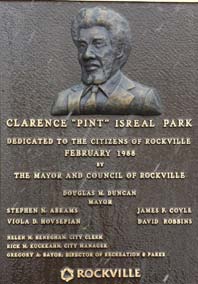 |
Commemorative plaquein Clarence "Pint" IsrealPark in Rockville, Md. |
"I got a check for a little over $1,000 as a member of the victorious team in that 7-game series. Compare that to what they get today," he said in a 1970 interview with The NIH Record (page 5) ![]() (15.9 KB).
(15.9 KB).
Isreal played with Hall of Fame athletes Satchel Paige, Jackie Robinson, Josh Gibson and Cool Papa Bell. Just a few years after the victory, he stepped behind the plate again but this time as a player-manager of the NIH club baseball team. In 1951, Isreal helped the team bring home 45 wins and the honor of being the best in the Washington-area out of 233 local teams.
When he wasn't out on the field, Isreal worked as a lab technician with the Laboratory of Biophysical Chemistry in the National Institute of Arthritis and Metabolic Diseases. He worked at NIH until 1973.
A park near the Lincoln Park Community Center in Rockville was named after Isreal, who passed away in 1987. See more information and photos [disclaimer].
Dental association honors Dr. Bruce Baum for training initiatives
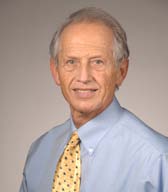 |
Dr. Bruce Baum has a continuous interest in helping young health professionals. |
In late March, the American Association for Dental Research honored Dr. Bruce Baum, director of the Clinical Center Medical Research Scholars Program, as the 2014 recipient of the Jack Hein Public Service Award [disclaimer]. Baum was chosen for his exemplary service in the area of public affairs by promoting the interests and activities of oral health research.
"His dedication to the program and the research community, particularly the dental and oral health fields, has contributed to our scientific knowledge and the overall health of the public," said Peter Polverini, the immediate past president of the American Association for Dental Research.
Baum has worked at the NIH for nearly 40 years. He retired from the National Institute of Dental and Craniofacial Research in late 2011 and transitioned to his current position. As director of the Medical Research Scholars Program, he develops the academic curriculum for the comprehensive, year-long research enrichment program designed to attract the most creative, research-oriented medical, dental and veterinary students to the intramural campus.
Visitors clown around with patients, bring an uplifting atmosphere
| ||
|
Large chromosomes found in frog, salamander eggs offer clues about RNA transcription
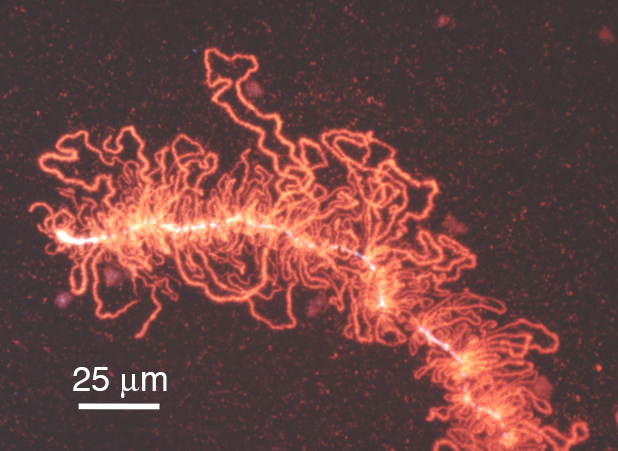 |
A small portion of a lampbrush chromosome. Photo courtesy of Dr. Joseph Gall. |
A Carnegie Institution for Science cell biologist reviewed his studies on exceptionally large chromosomes within the eggs of salamanders and frogs during a recent NIH Director's Wednesday Afternoon Lecture in Masur Auditorium.
Dr. Joseph Gall, who is with the Department of Embryology and is an Albert Lasker Special Achievement recipient, studies "lampbrush" chromosomes in developing eggs. These chromosomes are structures in which actively transcribing genes are visible by conventional light microscopy.
While under a microscope, they look like test tube brushes. What look like bristles on a brush are actually loops consisting of genes that are undergoing RNA transcription, said Gall.
The lampbrush chromosomes are found inside a giant nucleus (about .4 millimeters in diameter), called a germinal vesicle. Because the germinal vesicle is so big, researchers can remove it from the eggs and conduct both biochemical and cell biological studies.
Scientific information coming from studies such as Gall's could be useful in gene regulatory processing.
During the lecture, he also spoke about deep sequencing of developing eggs. View the lecture Giant chromosomes and deep sequences: What the frog egg tells us about RNA transcription.
Upcoming Events
Lectures will be streamed and archived
Contemporary Clinical Medicine: Great Teachers Lecture
Severe Combined Immunodeficiency: Lessons Learned and Hope and Concerns for the Future
April 9, 2014; Noon - 1:00 p.m.
Lipsett Amphitheater
Presented by Rebecca H. Buckley, MD, Duke University School of Medicine.
Clinical Center Grand Rounds Lecture
Liver Disease, an Increasingly Important Component of Global Health; and Drug-Induced Liver Injury
April 16, 2014, Noon - 1:00 p.m.
Lipsett Amphitheater
Presented by Christopher Koh, MD, MHSc, NIDDK and Jay Hoofnagle, MD, NIDDK.
NIH Director's Wednesday Afternoon Lecture Series
Genetics of Human Cancer
April 16, 2014; 3:00 p.m. - 4:00 p.m.
Masur Auditorium
Presented by Raju Kucherlapati, PhD, Harvard Medical School.
Deputy Director for Management Seminar Series
Breaking Down Silos
April 17, 2004; 11:00 a.m. - 12:30 p.m.
Masur Auditorium
Presented by Peg Neuhauser. More information: http://www.ddmseries.od.nih.gov.
Earth Day
April 22, 2014
NIH Earth Day at the Bethesda Campus will be a celebration with activities and information for NIH employees, contractors, visitors, and children here for Take Your Child to Work Day. This is a NIH Zero Waste Event! All waste will be composted or recycled.
Clinical Center Grand Rounds Lecture
The Biology of Aging and In Search of the Aging Phenotype
April 23, 2014, Noon - 1:00 p.m.
Lipsett Amphitheater
Presented by Toren Finkel, MD, PhD, NHLBI and Luigi Ferrucci, MD, NIA.
NIH Director's Wednesday Afternoon Lecture Series
Assembly, Disassembly and Reassembly of Circuits in the Retina
April 23, 2014; 3:00 p.m. - 4:00 p.m.
Masur Auditorium
Presented by Rachel Wong, PhD, University of Washington.
Take Your Child to Work Day
April 24, 2014; 9:00 a.m. 4:00 p.m.
Staff are invited to bring school-aged children grades 1-12 to engage in a day of healthy discovery. Registration is required. Questions? Email: Take-Your-Child-To-Work@nih.gov
USA Science and Engineering Festival [disclaimer]
April 26-27, 2014; 9:00 a.m. 6:00 p.m.
Walter E. Washington Convention Center, 801 Mount Vernon Place, Washington, DC
NIH Institutes and Centers are helping reinvigorate the interest of the nation's youth in science, technology, engineering and math. Free and open to the public.
Clinical Center Grand Rounds Lecture; Ethics Rounds
NIH Research with Chimpanzees: Implementing the Institute of Medicine Report
April 30, 2014; Noon - 1:00 p.m.
Lipsett Auditorium
Presented by Francis S. Collins, MD, PhD, NIH and Jeffrey Kahn, PhD, MPH, Johns Hopkins Berman Institute of Bioethics.
NIH Director's Wednesday Afternoon Lecture Series
Toward a Universal Influenza Virus Vaccine
April 30, 2014; 3:00 p.m. - 4:00 p.m.
Masur Auditorium
Presented by Peter Palese, PhD, Mount Sinai Hospital.
NOTE: PDF documents require the free Adobe Reader.
 The information on this page is archived and provided for reference purposes only.
The information on this page is archived and provided for reference purposes only.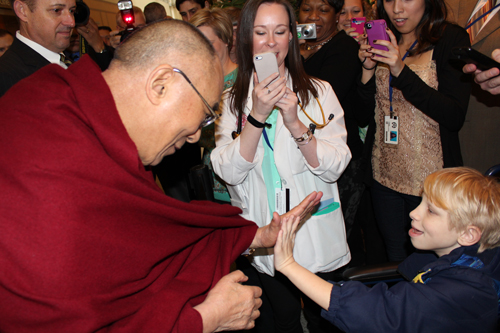 His Holiness, the 14th Dalai Lama, Tenzin Gyatso, visited the Clinical Center March 7. After first arriving he took the time to say hello to staff, patients and visitors. Pediatric patient Jacob Ludwig received a special high-five from the spiritual leader. "It was a wonderful experience!" said Jim Ludwig, Jacob's father. The Dalai Lama later presented at the NIH J. Edward Rall Cultural Lecture on the importance of science in human flourishing. "Science is truly making a contribution for wellbeing," he said. "I appreciate many scientific friends. Their mind [is] quite neutral and they look at anything, more objectively. That's good. That's really important in order to carry out [an] investigation. Skepticism [and] doubt are highly necessary."
His Holiness, the 14th Dalai Lama, Tenzin Gyatso, visited the Clinical Center March 7. After first arriving he took the time to say hello to staff, patients and visitors. Pediatric patient Jacob Ludwig received a special high-five from the spiritual leader. "It was a wonderful experience!" said Jim Ludwig, Jacob's father. The Dalai Lama later presented at the NIH J. Edward Rall Cultural Lecture on the importance of science in human flourishing. "Science is truly making a contribution for wellbeing," he said. "I appreciate many scientific friends. Their mind [is] quite neutral and they look at anything, more objectively. That's good. That's really important in order to carry out [an] investigation. Skepticism [and] doubt are highly necessary." 